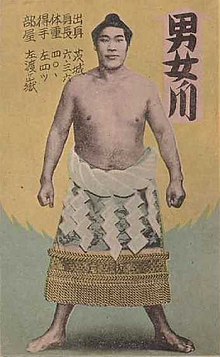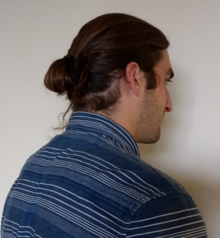Bun (hairstyle)
This article needs additional citations for verification. (April 2015) |

A bun is a type of hairstyle in which the hair is pulled back from the face, twisted or plaited, and wrapped in a circular coil around itself, typically on top or back of the head or just above the neck. A bun can be secured with a hair tie, barrette, bobby pins, one or more hair sticks, a hairnet, or a pen or pencil. Hair may also be wrapped around a piece called a "rat".[1][2] Alternatively, hair bun inserts, or sometimes rolled up socks, may also be used to create donut-shaped buns. Buns may be tightly gathered, or loose and more informal.
Double bun

Double or pigtail buns are often called odango[3] (お団子, odango), which is also a type of Japanese dumpling (usually called dango; the o- is honorific).
The term was popularized by the anime and manga series Sailor Moon,[citation needed] whose eponymous heroine and other characters wear their hair in this style. The term odango in Japanese can refer to any variety of bun hairstyle.
In China, the hairstyle is called niújiǎotóu (牛角头).[4] It was a commonly used hairstyle up until the early 20th century, and can still be seen today when traditional attire is used. This hairstyle differs from the odango slightly in that it is gender neutral; Chinese paintings of children have frequently depicted girls as having matching ox horns, while boys have a single bun in the back.
Triple bun
Star Wars: The Force Awakens had Rey debut a "triple bun" hairstyle.[5]
Bun or top knot hairstyle in men
Men in China wore their hair in a topknot bun as early as 200BC as depicted on the terracotta soldiers. They were worn until the end of the Ming Dynasty in AD 1644, after which the Qing Dynasty government forced men to adopt the Han Chinese queue hairstyle (queue order).

Men of the Joseon Era of Korea wore the sangtu as a symbol of marriage. 16th century Japanese men wore the chonmage for samurai warriors and sumo wrestlers. [citation needed] In the west, topknots were frequently worn by "barbarian" peoples in the eyes of the Romans, such as the Goths, Vandals, and the Lombards.[citation needed] Later, the hairstyle survived in the pagan Scandinavian north (some believe the topknot hairstyle contains elements of Odinic cult worship)[citation needed] and with the eastern nomadic tribes such as the Bulgars, Cumans and Cossacks. [citation needed]
Historical examples of men with long hair using this style include:
- The Hindu deity Shiva
- 6th-7th century BCE — Buddha
- 3rd century BCE—Terracotta Warriors of China
Rishi knot
The rishi (sage) knot is a topknot worn by Sikh boys and men as a religious practice, in which the hair is formed into a bun. In the Sikh tradition, a turban is then worn atop the bun.[6][7] This hairstyle is also known as joora, and has been traditionally worn by Hindu mendicants.[8]
Man bun

The man-bun is a topknot worn by long-haired men in the Western world. In London, the modern man bun style may have begun around 2010 although David Beckham sported one earlier. The first Google Trends examples started to appear in 2013, and searches showed a steep increase through 2015.[9] Some of the first celebrities to wear the style were Jared Leto, Joakim Noah, Chris Hemsworth, Leonardo DiCaprio and Orlando Bloom. The hairstyle is also associated with Brooklyn hipsters.[10]
See also
- Guanli, the traditional Chinese coming of age ceremony, after which men ceased to trim their hair and wore it as a bun or topknot
- Chonmage, the topknot of the Edo-period Japanese samurai
- Chignon
- Bantu knot
References
- ^ "Hair Rats: Creating Voluminous, Perfect Buns". Bouffants and Beehives. August 3, 2012.
- ^ "Hair Rats". Pin Curl Magazine. 2010-05-01. Archived from the original on 2018-08-01. Retrieved 2018-05-18.
- ^ Lowery, Allison (2013). "Appendix 1, Glossary of Hairstyling Terms". Historical Wig Styling: Ancient Egypt to the 1830s. Taylor & Francis. p. 259. ISBN 9780240821238.
- ^ "颜值自信者请进!学扎明星同款牛角头". 爱美女性网. Retrieved 19 October 2016.
- ^ Kim, Monica (16 December 2015). "Is Daisy Ridley's Star Wars Hair Making Its Way From the Big Screen to the Street?". vogue.com.
Rey's triple bun is the latest evolution in Star Wars hair history—after Leia's twin buns and Padmé's black Kabuki wig—and it puts a surprisingly modern spin on interstellar style. And so we wondered: Like the Katniss Everdeen braid and the Mad Max buzz cut before it, could the Star Wars triple bun become the next cinematic hairstyle with crossover appeal to hit the streets?
- ^ Levete, Sarah (15 August 2009). Preparing to come of age. Rosen Publishing. p. 30. ISBN 9781435853508.
{{cite book}}:|work=ignored (help) - ^ "Officially Selected Cases Argued and Determined in the Court of Appeals of the State of Kansas". Vol. 1. Court of Appeals of Kansas. 1977. p. 497.
The man shall tie his hair in a Rishi knot on the crown of his head to be covered by a cotton cloth known as a turban whenever in public.
{{cite magazine}}: Cite magazine requires|magazine=(help) - ^ Hume, Lynne (24 October 2013). p. 97. ISBN 9781472567475.
{{cite book}}:|work=ignored (help); Missing or empty|title=(help) - ^ Cochrane, Lauren (2013-10-16). "Man buns: a hair-raising trend". The Guardian. Retrieved 2017-07-12.
- ^ Edwards, Phil (2015-09-22). "Man buns, explained". Vox Media. Vox Media, Inc. Retrieved 2017-07-12.
External links
 Media related to Bun hairstyle at Wikimedia Commons
Media related to Bun hairstyle at Wikimedia Commons The dictionary definition of bun (hairstyle) at Wiktionary
The dictionary definition of bun (hairstyle) at Wiktionary
